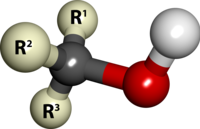
Photo from wikipedia
AbstractModified nucleosides have been an important target for pharmaceutical development for the treatment of cancer, herpes simplex virus, and the human immunodeficiency virus (HIV). Amongst these nucleoside analogues, those based… Click to show full abstract
AbstractModified nucleosides have been an important target for pharmaceutical development for the treatment of cancer, herpes simplex virus, and the human immunodeficiency virus (HIV). Amongst these nucleoside analogues, those based on 2′,3′-dideoxyribose sugars are quite common, particularly in anti-HIV applications. The gas-phase structures of several protonated 2′,3′-dideoxyribose nucleosides are examined in this work and compared with those of the analogous protonated DNA, RNA, and arabinose nucleosides to elucidate the influence of the 2′- and combined 2′,3′-hydroxyl groups on intrinsic structure. Infrared multiple photon dissociation (IRMPD) action spectra are collected for the protonated 2′,3′-dideoxy forms of adenosine, guanosine, cytidine, thymidine and uridine, [ddAdo+H]+, [ddGuo+H]+, [ddCyd+H]+, [ddThd+H]+, and [ddUrd+H]+, in the IR fingerprint and hydrogen-stretching regions. Molecular mechanics conformational searching followed by electronic structure calculations generates low-energy conformers of the protonated 2′,3′-dideoxynucleosides and corresponding predicted linear IR spectra to facilitate interpretation of the measured IRMPD action spectra. These experimental IRMPD spectra and theoretical calculations indicate that the absence of the 2′- and 3′-hydroxyls largely preserves the protonation preferences of the canonical forms. The spectra and calculated structures indicate a slight preference for C3′-endo sugar puckering. The presence of the 3′- and further 2′-hydroxyl increases the available intramolecular hydrogen-bonding opportunities and shifts the sugar puckering modes for all nucleosides but the guanosine analogues to a slight preference for C2′-endo over C3′-endo. Graphical Abstract